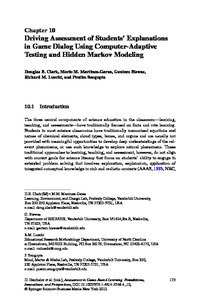Driving Assessment of Students´ Explanations in Game Dialog Using Computer-Adaptive Testing and Hidden Markov ModelingDouglas B. Clark, Mario M. Martinez-Garza, Gautam Biswas, Richard M. Luecht
Zu finden in: Assessment in Game-Based Learning (Seite 173 bis 199), 2012
|
 |
 Diese Seite wurde seit mehr als 7 Monaten inhaltlich nicht mehr aktualisiert.
Unter Umständen ist sie nicht mehr aktuell.
Diese Seite wurde seit mehr als 7 Monaten inhaltlich nicht mehr aktualisiert.
Unter Umständen ist sie nicht mehr aktuell.
 Zusammenfassungen
Zusammenfassungen
How might research on metacognition, conceptual change, and students´ explanations inform the design of dialog systems in digital games to foster science learning and engagement? How might research on computer-adaptive testing (CAT) and hidden Markov modeling support online diagnostic modeling of students´ learning behaviors and understanding? How might a game analyze their problem-solving steps as well as explanation constructs in that dialog? This chapter explores these questions. Our goals involve (1) scaffolding students´ explicit articulation of connections between intuitive understandings and disciplinary concepts in the game environment while (2) providing mechanisms for online tracking of players´ evolving understanding to support adaptive scaffolding and provide formative and summative diagnostic information to teachers and researchers. Essentially, we propose that integrating research on conceptual change, scientific explanations, metacognition, CAT, and hidden Markov modeling in a digital game environment could simultaneously diagnose the formative and summative aspects of students´ understanding, and in this process provide an environment that fosters deep science learning. We first define the challenge of scaffolding deep learning in games at the cognitive level by contrasting constraint-based reasoning and model-based reasoning. We then explore the role of self-explanation in supporting model-based reasoning and dynamic assessment of students´ reasoning. This is followed by an outline of a model for game-based dialog to support explanation generation and analysis. This explanation dialog model leverages CAT techniques and hidden Markov modeling to develop and refine an ongoing analysis of a students´ understanding within the game based on students´ explanations within the dialog and their other actions within the game.
Von Douglas B. Clark, Mario M. Martinez-Garza, Gautam Biswas, Richard M. Luecht im Buch Assessment in Game-Based Learning (2012) im Text Driving Assessment of Students´ Explanations in Game Dialog Using Computer-Adaptive Testing and Hidden Markov Modeling  Dieses Kapitel erwähnt ...
Dieses Kapitel erwähnt ...
 Begriffe KB IB clear |  Computer Computer computer
, concept inventory (CIL)
, game-based learninggame-based learning computer
, concept inventory (CIL)
, game-based learninggame-based learning
|
 Anderswo finden
Anderswo finden
 Volltext dieses Dokuments
Volltext dieses Dokuments
 |  Driving Assessment of Students´ Explanations in Game Dialog Using Computer-Adaptive Testing and Hidden Markov Modeling: Artikel als Volltext bei Springerlink ( Driving Assessment of Students´ Explanations in Game Dialog Using Computer-Adaptive Testing and Hidden Markov Modeling: Artikel als Volltext bei Springerlink ( : :  , 501 kByte; , 501 kByte;  : :  2020-11-28) 2020-11-28) |
 Anderswo suchen
Anderswo suchen 
 Beat und dieses Kapitel
Beat und dieses Kapitel
Beat hat Dieses Kapitel während seiner Zeit am Institut für Medien und Schule (IMS) ins Biblionetz aufgenommen. Beat besitzt kein physisches, aber ein digitales Exemplar. Eine digitale Version ist auf dem Internet verfügbar (s.o.). Aufgrund der wenigen Einträge im Biblionetz scheint er es nicht wirklich gelesen zu haben. Es gibt bisher auch nur wenige Objekte im Biblionetz, die dieses Werk zitieren.










 Biblionetz-History
Biblionetz-History